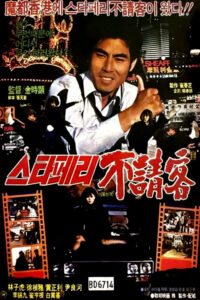Director: Kim Si-hyun
Cast: Im Ja-ho, Seo Jong-ah, Hwang Jang Lee, Heo Yang-mi, Yoon Yang-ha, Baek Hwang-ki, Park Hui-jin, Lee Suk-koo, Baek Hwang-ki, Choe Hyeong-geun
Running Time: 92 min.
By Paul Bramhall
When it comes to the niche world of Godfrey Ho’s infamous cut ‘n’ paste gweilo ninja movies, Ninja Terminator pretty much sits at the top of the pile. A cult oddity featuring Garfield phones, crab cookery gone wrong, and Richard Harrison with a heavy dose of eyeliner, when I first watched it in the early 2000’s the most that was known about the production the scenes had been spliced into was that it was a “low budget Korean kung-fu movie”. In the 20+ years since information on pre-21st century Korean cinema has become much more accessible, and thanks to resources like the Korean Movie Database, by the time the 2010’s rolled around it became common knowledge (well, at least in kung-fu cinema fan circles!) that the movie in question was called The Uninvited Guest of the Star Ferry.
Released in 1984, like so many Korean productions from the 1980’s, tragically it seemed like the original had been lost to the sands of time (Trouble Solving Broker being a classic example). While we don’t usually talk about specific releases on cityonfire, this time it’s worth to make an exception, as without the release in question there would never have been an opportunity to check out The Uninvited Guest of the Star Ferry in the first place. Thanks to Neon Eagle’s 2024 limited edition Blu-ray of Ninja Terminator, not only did they stack the release with special features, but they also managed to track down a 16mm print of The Uninvited Guest of the Star Ferry, complete with its original Korean audio. While it’s included in the set as one of the extras, for fans of Korean cinema – particularly the taekwon-action genre – the fact that a title once resigned as lost is now suddenly available to be enjoyed feels like nothing short of a miracle.
Directed by Kim Si-hyun, since debuting in 1965 with the drama A Long Journey, he soon found his calling as an action movie maker. From the swordplay genre that was popular in the 1960’s with titles like A Bloody Fight at Suramoon and A Wondering Swordsman, through to the taekwon-action era of the 1970’s, where he frequently partnered with Dragon Lee for the likes of Golden Dragon, Sliver Snake and Enter the Invincible Hero. In fact I’d argue no other filmmaker has had their movies suffer at the hands of the IFD Films crew than Si-hyun, with him being at the helm of many of the cut ‘n’ paste efforts that used Korean movies as their base. Apart from Ninja Terminator using The Uninvited Guest of the Star Ferry, in 1986 Ninja Champion bastardizes Si-hyun’s 1985 rape revenge thriller Poisonous Rose Stripping the Night, while 1988’s War City 2: Red Heat Conspiracy used his penultimate movie Maze of Love.
In fairness by 1984 Si-hyun’s persistence in creating taekwon-action flicks was a little out of step with the times. Many consider 1982’s previously mentioned Trouble Solving Broker to be the end of the taekwon-action era, before the Korean film industry increasingly turned its focus to cranking out erotic cinema for much of the decade, thanks to the loosening of censorship over how much skin could be shown on screen. However Si-hyun stuck to his guns, and would continue to push Im Ja-ho as a new taekwon-action leading man, following his turn in Nam Gi-nam’s Leopard Fist Ninja from 1982. A formidable kicker, while Ja-ho can be seen in the background of many a 1970’s taekwon-action production, his late promotion to leading man unfortunately never saw him become as popular as his counterparts from the previous decade like Han Yong-cheol and Bobby Kim.
In The Uninvited Guest of the Star Ferry Ja-ho plays a private investigator who arrives in Hong Kong (hence the reference to the Star Ferry in the title), intent on getting to the bottom of a restauranteurs murder in Korea Town. Tensions have been running high between the locals and the Korean community because the “Koreans work harder”, but the truth behind the murder could be closer to home. Hired by the victim’s sister (played by Seo Jong-ah – The Last Witness, The Hut) to find those responsible, soon Ja-ho is unleashing his ferocious footwork, possibly falling for the sister he’s been hired by, and taking flak from the Korea Expat Association for poking his nose where it’s not wanted. As a plot its functional if far from inspiring, there mainly to allow Ja-ho to frequently get into scuffles with taekwon-action regulars like Baek Hwang-ki and Park Hui-jin (rocking a haircut which makes him look like a case of Casanova Wong-sploitation!).
Of course one of the most infamous elements of Ninja Terminator is the presence of legendary super kicker Hwang Jang Lee, decked out in a ridiculous blonde wig, fake rubber hand, and white suit that would make any 42nd Street pimp proud. By the mid-80’s Jang Lee was no longer the omni-present villain that he was just a few years prior, with The Uninvited Guest of the Star Ferry being just one of 3 productions he’d feature in during 1984 (the other 2 being Demon Strike and Shaolin: The Blood Mission), compared to the 9 he featured in just a couple of years prior in 1982! One of the unexpected surprises of being able to watch the original is that there’s still no explanation as to why he’s wearing a blonde wig, although the fact that he’s named his lackey names like Duncan, Jackson, and Barabara somehow makes up for it.
The cuts between Hong Kong and Korea also provide a dose of unintentional amusement, with the HK footage mostly comprising of Ja-ho strolling down the unmistakable neon lit streets, before cutting back to the mountainous countryside of Korea where the main plot plays out (even though we’re still supposed to believe it’s HK). If Si-hyun’s geography is to be trusted, then apparently a Buddhist temple complex in the remote mountains is just a short stroll away from the busy streets of Kowloon. Thankfully the fights come thick and fast, and with contemporary set taekwon-action movies being a rarity in the genre, it’s a pleasure to watch Ja-ho unleash in a modern environment. The only part that requires a little adjustment is getting used to the way many of the fights play out to an upbeat soundtrack, one that sounds like it could be the opening to a daytime TV soap opera, offering up a slightly surreal feel to the violence onscreen.
The inoffensively pleasant soundtrack choice is at least offset by 1984 making The Uninvited Guest of the Star Ferry a latter entry in the genre, meaning that the choreography has developed in such a way that it’s noticeably more impactful than the early to mid-1970’s, when the genre was at its peak. Bodies go flying over cars in slow motion, somersaults result from kicks to the crotch, and of course, this is the only time that Im Ja-ho would face off against Hwang Jang Lee. Taking part in and around a port before segueing onto the beach, despite the 10 year age gap (with Ja-ho being younger) they both give as good as they get, with Si-hyun offering up a typically Korean detour into the absurd as Jang Lee’s leaping around sees him buried up to his waist in sand. In a career that’s seen the boot master beaten by everything from the sight of a woman’s breasts to cat kung-fu, death by accidentally burying yourself in sand is definitely up there.
Whilst far from being the best the genre has to offer, Si-hyeon still shows some occasional flourishes that reflect a filmmaker who cared about the final product. A sequence that sees Ja-ho sprinting to reach Seo Jong-ah before the bomb she’s been strapped to goes off is particularly effective, with the scene including a number of freeze frames to torturously extend the passing of time, while the sound of the bomb ticks away in the background. It’s a small touch, but it works well, instilling a sense of urgency into a genre where such feelings are usually reserved strictly for the fight scenes.
Throw in Kenny Loggins Footloose’, projectile dice, and ill-timed confessions of love, ultimately all of them come together to give The Uninvited Guest of the Star Ferry an odd charm that seems so unique to much of Korea’s output in the 1980’s. It may not be the perfect taekwon-action movie, but it should definitely scratch the itch for anyone seeking a dose of blonde wigged kicks to the face.
Paul Bramhall’s Rating: 6/10



